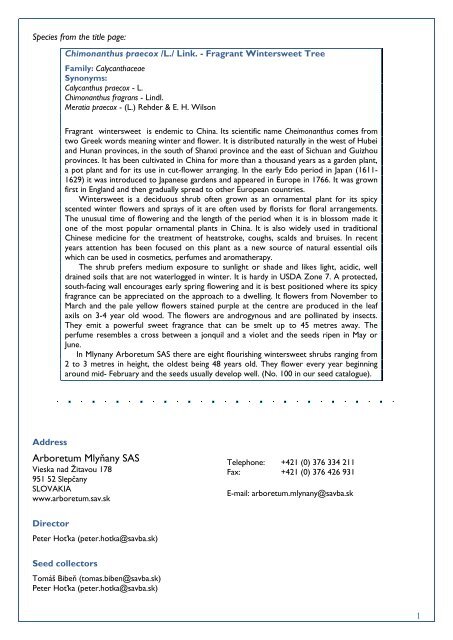Arboretum Mlyňany Slovak Academy of Sciences - Arborétum ...
Arboretum Mlyňany Slovak Academy of Sciences - Arborétum ...
Arboretum Mlyňany Slovak Academy of Sciences - Arborétum ...
Create successful ePaper yourself
Turn your PDF publications into a flip-book with our unique Google optimized e-Paper software.
Species from the title page:<br />
Address<br />
Chimonanthus praecox /L./ Link. - Fragrant Wintersweet Tree<br />
Family: Calycanthaceae<br />
Synonyms:<br />
Calycanthus praecox - L.<br />
Chimonanthus fragrans - Lindl.<br />
Meratia praecox - (L.) Rehder & E. H. Wilson<br />
Fragrant wintersweet is endemic to China. Its scientific name Cheimonanthus comes from<br />
two Greek words meaning winter and flower. It is distributed naturally in the west <strong>of</strong> Hubei<br />
and Hunan provinces, in the south <strong>of</strong> Shanxi province and the east <strong>of</strong> Sichuan and Guizhou<br />
provinces. It has been cultivated in China for more than a thousand years as a garden plant,<br />
a pot plant and for its use in cut-flower arranging. In the early Edo period in Japan (1611-<br />
1629) it was introduced to Japanese gardens and appeared in Europe in 1766. It was grown<br />
first in England and then gradually spread to other European countries.<br />
Wintersweet is a deciduous shrub <strong>of</strong>ten grown as an ornamental plant for its spicy<br />
scented winter flowers and sprays <strong>of</strong> it are <strong>of</strong>ten used by florists for floral arrangements.<br />
The unusual time <strong>of</strong> flowering and the length <strong>of</strong> the period when it is in blossom made it<br />
one <strong>of</strong> the most popular ornamental plants in China. It is also widely used in traditional<br />
Chinese medicine for the treatment <strong>of</strong> heatstroke, coughs, scalds and bruises. In recent<br />
years attention has been focused on this plant as a new source <strong>of</strong> natural essential oils<br />
which can be used in cosmetics, perfumes and aromatherapy.<br />
The shrub prefers medium exposure to sunlight or shade and likes light, acidic, well<br />
drained soils that are not waterlogged in winter. It is hardy in USDA Zone 7. A protected,<br />
south-facing wall encourages early spring flowering and it is best positioned where its spicy<br />
fragrance can be appreciated on the approach to a dwelling. It flowers from November to<br />
March and the pale yellow flowers stained purple at the centre are produced in the leaf<br />
axils on 3-4 year old wood. The flowers are androgynous and are pollinated by insects.<br />
They emit a powerful sweet fragrance that can be smelt up to 45 metres away. The<br />
perfume resembles a cross between a jonquil and a violet and the seeds ripen in May or<br />
June.<br />
In Mlynany <strong>Arboretum</strong> SAS there are eight flourishing wintersweet shrubs ranging from<br />
2 to 3 metres in height, the oldest being 48 years old. They flower every year beginning<br />
around mid- February and the seeds usually develop well. (No. 100 in our seed catalogue).<br />
<strong>Arboretum</strong> <strong>Mlyňany</strong> SAS<br />
Vieska nad Ţitavou 178<br />
951 52 Slepčany<br />
SLOVAKIA<br />
www.arboretum.sav.sk<br />
Director<br />
Peter Hoťka (peter.hotka@savba.sk)<br />
Seed collectors<br />
Tomáš Bibeň (tomas.biben@savba.sk)<br />
Peter Hoťka (peter.hotka@savba.sk)<br />
Telephone: +421 (0) 376 334 211<br />
Fax: +421 (0) 376 426 931<br />
E-mail: arboretum.mlynany@savba.sk<br />
1


